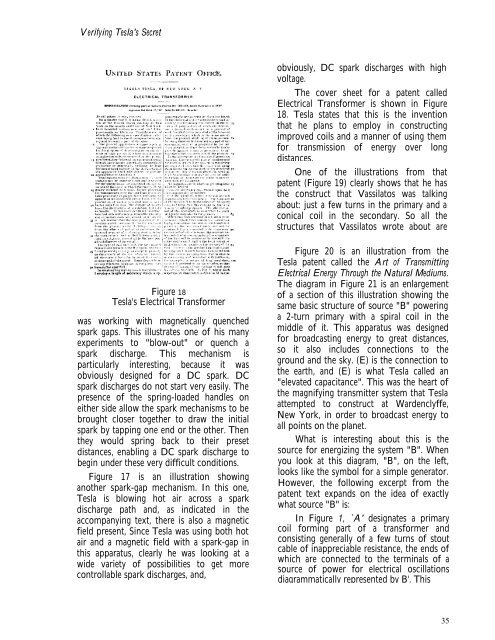Free%20Energy%20Secrets%20with%20Tesla%20patents
Free%20Energy%20Secrets%20with%20Tesla%20patents
Free%20Energy%20Secrets%20with%20Tesla%20patents
Create successful ePaper yourself
Turn your PDF publications into a flip-book with our unique Google optimized e-Paper software.
Verifying Tesla's Secret<br />
Figure 18<br />
Tesla's Electrical Transformer<br />
was working with magnetically quenched<br />
spark gaps. This illustrates one of his many<br />
experiments to "blow-out" or quench a<br />
spark discharge. This mechanism is<br />
particularly interesting, because it was<br />
obviously designed for a DC spark. DC<br />
spark discharges do not start very easily. The<br />
presence of the spring-loaded handles on<br />
either side allow the spark mechanisms to be<br />
brought closer together to draw the initial<br />
spark by tapping one end or the other. Then<br />
they would spring back to their preset<br />
distances, enabling a DC spark discharge to<br />
begin under these very difficult conditions.<br />
Figure 17 is an illustration showing<br />
another spark-gap mechanism. In this one,<br />
Tesla is blowing hot air across a spark<br />
discharge path and, as indicated in the<br />
accompanying text, there is also a magnetic<br />
field present, Since Tesla was using both hot<br />
air and a magnetic field with a spark-gap in<br />
this apparatus, clearly he was looking at a<br />
wide variety of possibilities to get more<br />
controllable spark discharges, and,<br />
obviously, DC spark discharges with high<br />
voltage.<br />
The cover sheet for a patent called<br />
Electrical Transformer is shown in Figure<br />
18. Tesla states that this is the invention<br />
that he plans to employ in constructing<br />
improved coils and a manner of using them<br />
for transmission of energy over long<br />
distances.<br />
One of the illustrations from that<br />
patent (Figure 19) clearly shows that he has<br />
the construct that Vassilatos was talking<br />
about: just a few turns in the primary and a<br />
conical coil in the secondary. So all the<br />
structures that Vassilatos wrote about are<br />
Figure 20 is an illustration from the<br />
Tesla patent called the Art of Transmitting<br />
Electrical Energy Through the Natural Mediums.<br />
The diagram in Figure 21 is an enlargement<br />
of a section of this illustration showing the<br />
same basic structure of source "B" powering<br />
a 2-turn primary with a spiral coil in the<br />
middle of it. This apparatus was designed<br />
for broadcasting energy to great distances,<br />
so it also includes connections to the<br />
ground and the sky. (E) is the connection to<br />
the earth, and (E) is what Tesla called an<br />
"elevated capacitance". This was the heart of<br />
the magnifying transmitter system that Tesla<br />
attempted to construct at Wardenclyffe,<br />
New York, in order to broadcast energy to<br />
all points on the planet.<br />
What is interesting about this is the<br />
source for energizing the system "B". When<br />
you look at this diagram, "B", on the left,<br />
looks like the symbol for a simple generator.<br />
However, the following excerpt from the<br />
patent text expands on the idea of exactly<br />
what source "B" is:<br />
In Figure 1, `A' designates a primary<br />
coil forming part of a transformer and<br />
consisting generally of a few turns of stout<br />
cable of inappreciable resistance, the ends of<br />
which are connected to the terminals of a<br />
source of power for electrical oscillations<br />
diagrammatically represented by B'. This<br />
35












![[Pham_Sherisse]_Frommer's_Southeast_Asia(Book4You)](https://img.yumpu.com/38206466/1/166x260/pham-sherisse-frommers-southeast-asiabook4you.jpg?quality=85)




